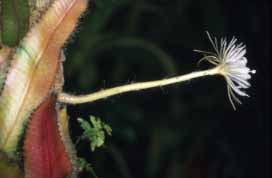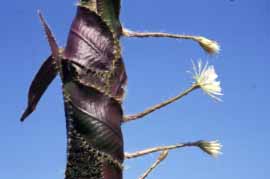|
Strophocactus Sicariguensis
''Strophocactus sicariguensis'', synonym ''Pseudoacanthocereus sicariguensis'', is a species of plant in the family Cactaceae. It is native to Colombia and Venezuela. It has often sprawling thin stems and white funnel-shaped flowers that open at night. Description ''Strophocactus sicariguensis'' grows as a shrub, initially upright and later sprawling. It branches freely from the base. The thin stems are up to long and across and have 2–5 ribs bearing areoles with spines up to long. The white funnel-shaped flowers open at night and are up to long. Taxonomy ''Strophocactus sicariguensis'' was first described, as ''Acanthocereus sicariguensis'', in 1947. It was transferred to the genus ''Pseudoacanthocereus'' as ''Pseudoacanthocereus sicariguensis'' by Nigel P. Taylor in 1992, a placement still accepted by some sources . A molecular phylogenetic study of the Hylocereeae by Korotkova et al. published in 2017 showed that ''Pseudoacanthocereus sicariguensis'' formed a clade with ... [...More Info...] [...Related Items...] OR: [Wikipedia] [Google] [Baidu] |
Synonym (taxonomy)
The Botanical and Zoological Codes of nomenclature treat the concept of synonymy differently. * In botanical nomenclature, a synonym is a scientific name that applies to a taxon that (now) goes by a different scientific name. For example, Linnaeus was the first to give a scientific name (under the currently used system of scientific nomenclature) to the Norway spruce, which he called ''Pinus abies''. This name is no longer in use, so it is now a synonym of the current scientific name, ''Picea abies''. * In zoology, moving a species from one genus to another results in a different binomen, but the name is considered an alternative combination rather than a synonym. The concept of synonymy in zoology is reserved for two names at the same rank that refers to a taxon at that rank - for example, the name ''Papilio prorsa'' Linnaeus, 1758 is a junior synonym of ''Papilio levana'' Linnaeus, 1758, being names for different seasonal forms of the species now referred to as ''Araschnia le ... [...More Info...] [...Related Items...] OR: [Wikipedia] [Google] [Baidu] |
Strophocactus Wittii
''Strophocactus wittii'', synonym ''Selenicereus wittii'', known as the Amazon moonflower, is a species of plant in the genus '' Strophocactus'' in the cactus family (Cactaceae), and is one of several species commonly called "moonflowers". It was first described in 1900 and is one of three species of cactus found in the central Amazon basin. It grows epiphytically on the trunks of trees in seasonally flooded forests of the Amazon basin, which is regularly flooded for a few weeks each year. During this time, the seeds spread through the water, which is unique within the cactus family. Description Vegetative characteristics ''Strophocactus wittii'' grows as an epiphyte, creeping and climbing up trees. The richly branched, leaf-like, flattened stems are phylloclades, and are pressed close to the tree trunks of their carriers and form aerial roots along their midrib. When exposed to direct sunlight, the elliptical to lanceolate, dark green shoots turn dull red due to strong b ... [...More Info...] [...Related Items...] OR: [Wikipedia] [Google] [Baidu] |
Flora Of Venezuela
The flora of Venezuela consists of a huge variety of unique plants; around 38% of the estimated 30,000 species of plants found in the country are endemic to Venezuela. Overall, around 48% of Venezuela's land is forested; this includes over 60% of the Venezuelan Amazon. These rainforests are increasingly endangered by mining and logging activities. Venezuela's habitats range from the Andes mountains in the west to the Amazon Basin rainforest in the south, via extensive Llanos plains and Caribbean coast in the center and the Orinoco River Delta in the east. They include xeric scrublands in the extreme northwest and coastal mangrove forests in the northeast. Its cloud forests and lowland rainforests are particularly rich, for example hosting over 25,000 species of orchids.Dydynski, K; Beech, C (2004). Venezuela'. Lonely Planet. . Retrieved 10 March 2007. p42 These include the ''flor de mayo'' orchid (''Cattleya mossiae''), the national flower. Venezuela's national tree is the '' arag ... [...More Info...] [...Related Items...] OR: [Wikipedia] [Google] [Baidu] |
Flora Of Colombia
The Flora of Colombia is characterized by over 28,000 species of green plants. National Flower of Colombia The national flower of Colombia is the orchid ''Cattleya trianae'' which was named after the Colombian naturalist José Jerónimo Triana. The orchid was selected by botanist Emilio Robledo, in representation of the Colombian Academy of History to determine the most representative flowering plant of Colombia. He described it as one of the most beautiful flowers in the world and selected ''Cattleya trianae'' as National symbol. National Tree of Colombia The national tree of Colombia is the palm ''Ceroxylon quindiuense'' (Quindío wax palm) which was named after the Colombian Department of Quindío where is located the Cocora valley, the only habitat of this restricted range species. The Quindío wax palm was selected as the national tree by the government of Belisario Betancur and was the first tree officially declared as a protected species in Colombia. ''C.quindiuens ... [...More Info...] [...Related Items...] OR: [Wikipedia] [Google] [Baidu] |
Echinocereeae
The Echinocereeae are a tribe of cactus, cacti in the subfamily Cactoideae. Since 2006, the tribe has included the former tribe Pachycereeae in many treatments of cactus classification. The exact Circumscription (taxonomy), circumscription of the tribe has been subject to considerable change, particularly since Molecular phylogenetics, molecular phylogenetic approaches have been used in determining classifications, and remains uncertain. The tribe includes large treelike species, such as the saguaro (''Carnegiea gigantea''), as well as shorter shrubby species. Most members of the tribe are found in desert regions, particularly in Mexico and the southwestern United States. Description The tribe includes large treelike species, as well as shorter shrubby species. Some species can grow to be over tall, like the saguaro (''Carnegiea gigantea'') and ''Neobuxbaumia macrocephala''. Their stems are ribbed and columnar, not divided into segments. Most have flowers that open at night. Tax ... [...More Info...] [...Related Items...] OR: [Wikipedia] [Google] [Baidu] |
Maracaibo Basin
The Maracaibo Basin, also known as Lake Maracaibo natural region, Lake Maracaibo depression or Lake Maracaibo Lowlands, is a foreland basin and one of the eight natural regions of Venezuela, found in the northwestern corner of Venezuela in South America. Covering over 36,657 square km, it is a hydrocarbon-rich region that has produced over 30 billion bbl of oil with an estimated 44 billion bbl yet to be recovered. The basin is characterized by a large shallow tidal estuary, Lake Maracaibo, located near its center. The Maracaibo basin has a complex tectonic history that dates back to the Jurassic period with multiple evolution stages. Despite its complexity, these major tectonic stages are well preserved within its stratigraphy. This makes The Maracaibo basin one of the most valuable basins for reconstructing South America's early tectonic history. Geologic setting The Maracaibo basin is surrounded by two mountain ranges, the Méridas Andes to the southeast and the Sierra de Perij ... [...More Info...] [...Related Items...] OR: [Wikipedia] [Google] [Baidu] |
Strophocactus
''Strophocactus'' is a genus of cacti in the subfamily Cactoideae. Its status and circumscription remain somewhat uncertain, with the genus containing one to three species (not always the same ones). Molecular phylogenetic data suggest that it consists of three species, including two formerly comprising the genus ''Pseudoacanthocereus''. With this circumscription, the species have different growth habits, but share similarities in their flowers, which are white and open at night. Description As circumscribed by Korotkova et al. in 2017, the three species of ''Strophocactus'' have tubular to funnel-shaped flowers with tubercules arranged in ribs and areoles with bristles. The flowers are white and open at night. They are followed by yellow to brown fruits. Two species (''S. brasiliensis'' and ''S. sicariguensis'') are scrambling or decumbent shrubs, with thin stems (up to 4.5 cm across) and tuberous roots. ''S. sicariguensis'' sometimes has flattened stem segmen ... [...More Info...] [...Related Items...] OR: [Wikipedia] [Google] [Baidu] |
Neoraimondia Herzogiana
''Neoraimondia'' is a genus of medium to large cacti from Peru. The genus is named after the Italian-born Peruvian explorer, naturalist, and scientist, Antonio Raimondi. It is a psychoactive cacti and its different cacti have been known to contain the chemicals 3,5-Dimethoxy-4-hydroxyphenethylamine and 3,4-Dimethoxyphenethylamine. It is mixed into a hallucinogenic beverage called "Cimora" along with Trichocereus pachanoi ''Echinopsis pachanoi'' (syn. ''Trichocereus pachanoi'')—known as San Pedro cactus—is a fast-growing columnar cactus native to the Andes Mountains at in altitude. It is found in Argentina, Bolivia, Colombia, Chile, Ecuador and Peru, and it .... Species References Cactoideae genera {{Cactus-stub ... [...More Info...] [...Related Items...] OR: [Wikipedia] [Google] [Baidu] |
Hylocereeae
The Hylocereeae are a tribe of cacti. Most are found in the tropical forests of Central and northern South America, and are climbers or epiphytes, unlike most cacti. The tribe includes between six and eight genera in different circumscriptions. The plants known as "epiphyllum hybrids" or "epiphyllums", widely grown for their flowers, are hybrids of species within this tribe, particularly ''Disocactus'', ''Pseudorhipsalis'' and ''Selenicereus'', less often ''Epiphyllum'', in spite of the common name. Description The members of the tribe are very variable in their morphology, especially when the terrestrial ''Acanthocereus'' is included. Many species form aerial roots. The hylocereoid clade (''Selenicereus'', ''Weberocereus'' and probably ''Aporocactus'') are mostly climbing or epiphytic, and have spiny ribbed stems. The phyllocactoid clade (''Epiphyllum'', ''Disocactus'', ''Kimnachia'' and ''Pseudorhipsalis'') are mainly epiphytic, and have spineless flattened leaf-like stems. F ... [...More Info...] [...Related Items...] OR: [Wikipedia] [Google] [Baidu] |
Plant
Plants are predominantly photosynthetic eukaryotes of the kingdom Plantae. Historically, the plant kingdom encompassed all living things that were not animals, and included algae and fungi; however, all current definitions of Plantae exclude the fungi and some algae, as well as the prokaryotes (the archaea and bacteria). By one definition, plants form the clade Viridiplantae (Latin name for "green plants") which is sister of the Glaucophyta, and consists of the green algae and Embryophyta (land plants). The latter includes the flowering plants, conifers and other gymnosperms, ferns and their allies, hornworts, liverworts, and mosses. Most plants are multicellular organisms. Green plants obtain most of their energy from sunlight via photosynthesis by primary chloroplasts that are derived from endosymbiosis with cyanobacteria. Their chloroplasts contain chlorophylls a and b, which gives them their green color. Some plants are parasitic or mycotrophic and have lost the ... [...More Info...] [...Related Items...] OR: [Wikipedia] [Google] [Baidu] |
Molecular Phylogenetics
Molecular phylogenetics () is the branch of phylogeny that analyzes genetic, hereditary molecular differences, predominantly in DNA sequences, to gain information on an organism's evolutionary relationships. From these analyses, it is possible to determine the processes by which diversity among species has been achieved. The result of a molecular phylogenetic analysis is expressed in a phylogenetic tree. Molecular phylogenetics is one aspect of molecular systematics, a broader term that also includes the use of molecular data in taxonomy and biogeography. Molecular phylogenetics and molecular evolution correlate. Molecular evolution is the process of selective changes (mutations) at a molecular level (genes, proteins, etc.) throughout various branches in the tree of life (evolution). Molecular phylogenetics makes inferences of the evolutionary relationships that arise due to molecular evolution and results in the construction of a phylogenetic tree. History The theoretical frame ... [...More Info...] [...Related Items...] OR: [Wikipedia] [Google] [Baidu] |
Nigel Paul Taylor
Nigel Paul Taylor (born 1956) is a British botanist. He mainly focuses on the study of cacti. Taylor has been director of the Singapore Botanic Gardens since September 2011. He was previously curator of the Kew Gardens in London London is the capital and largest city of England and the United Kingdom, with a population of just under 9 million. It stands on the River Thames in south-east England at the head of a estuary down to the North Sea, and has been a majo .... References External links 1956 births Living people Date of birth missing (living people) Place of birth missing (living people) British botanists {{botanist-stub ... [...More Info...] [...Related Items...] OR: [Wikipedia] [Google] [Baidu] |

%2C_Venezuela.jpg)




